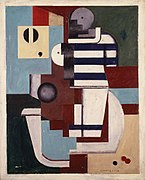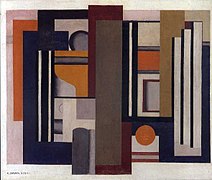Sakata Kazuo
Sakata Kazuo ( Japanese 坂 田 一 男 ; born August 22, 1889 in Okayama , Okayama Prefecture ; died May 28, 1956 ) was a Japanese cubist-style painter during the Taishō and Shōwa periods .
life and work
Sakata Kazuo was born in Okayama, moved to Tokyo in 1914 and studied painting at the Hongō Art School ( 本 郷 絵 画 研究所 , Hongō kaiga kenkyūjo ) and the Kawabata Art School ( 川端 画 学校 , Kawabata gagakkō ). In 1921 he went to France and trained under Emile-Othon Friez and since autumn 1924 under Fernand Léger . That was the time when he became interested in cubism. His works from this period show that he initially built on the basic ideas of Cubism, then approached Léger's style from 1924 to 1926. There were many Japanese painters living in Paris at the time, but none of them studied Cubism as thoroughly as Sakata. During his stay in France he submitted works to the Salon d'Autumne , the Salon des Tuileries and the Société des Artistes Indépendants , but also organized his own exhibitions.
In 1933 Sakata returned to Japan and built a studio in Tamashima, a district of Kurashiki , near his hometown. After the Pacific War he founded the avant-garde group AGO (Avant-garde Okayama) in Okayama. He was very active there, exhibiting his pictures and teaching his students in Okayama, without any significant contact with the artists' circles in Tokyo. The pictures from the last years of his life still show his tendency towards abstraction.
photos
literature
- Japan Foundation (Ed.): Sakata Kazuo . In: Japanese painting in the western style, 19th and 20th centuries. Exhibition catalog, Cologne, 1985.
Web links
| personal data | |
|---|---|
| SURNAME | Sakata, Kazuo |
| ALTERNATIVE NAMES | 坂 田 一 男 (Japanese) |
| BRIEF DESCRIPTION | Japanese painter |
| DATE OF BIRTH | August 22, 1889 |
| PLACE OF BIRTH | Okayama |
| DATE OF DEATH | May 28, 1956 |





